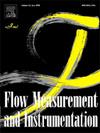在装有阻塞屏的风洞中测量流量
IF 2.3
3区 工程技术
Q2 ENGINEERING, MECHANICAL
引用次数: 0
摘要
由于中小型风力涡轮机在海上和陆上风电场应用中的适应性,其发展得到了改善。众多障碍物造成的阻塞效应限制了涡轮机附近的流场,影响了涡轮机的性能。由于没有带阻塞屏的定制风洞配置,在实验室一级对这种条件下的涡轮机进行测试和优化具有挑战性。本研究的重点是设计、开发和评估带和不带阻挡屏的风洞的空气动力性能。通过实验分析,对风洞中各部分的损失、不确定性、速度、力和湍流强度进行评估,从而确定综合设计方案。在风速为 2-14 m/s 的情况下,新型阻塞屏的阻塞率分别为 5% 和 10%。阻挡率为 5% 时,风速的最大降幅为 41.40%,阻挡率为 10% 时,风速的最大降幅为 67.84%。因此,可利用风能的最大降幅分别为 79.88 % 和 96.67 %。本文章由计算机程序翻译,如有差异,请以英文原文为准。
Flow measurement in a wind tunnel with blockage screens
The small and medium-scale wind turbine development have been improved due to their adaptability in offshore and onshore localities for wind farm applications. Blockage effects caused by numerous impediments restrict the flow-field near the turbine and impact the turbine's performance. The testing and optimization of turbines in such conditions at laboratory-level are challenging due to the unavailability of customized wind tunnel configurations with blockage screens. The present work focuses on the design, development and evaluating aerodynamic performance of wind tunnel with and without blockage screens. A comprehensive design is established by evaluating losses in each section, uncertainties, velocity, forces, and turbulence intensity in the wind tunnel through the experimental analysis. The novel blockage screens are arranged to maintain 5 % and 10 % blockage percentage for wind velocity range of 2–14 m/s. The maximum velocity reduction with 5 % blockage is 41.40 % and this drop reaches to 67.84 % for 10 % blockage. Consequently, available wind power is seen to undergo a maximum reduction of 79.88 % and 96.67 %, respectively.
求助全文
通过发布文献求助,成功后即可免费获取论文全文。
去求助
来源期刊

Flow Measurement and Instrumentation
工程技术-工程:机械
CiteScore
4.30
自引率
13.60%
发文量
123
审稿时长
6 months
期刊介绍:
Flow Measurement and Instrumentation is dedicated to disseminating the latest research results on all aspects of flow measurement, in both closed conduits and open channels. The design of flow measurement systems involves a wide variety of multidisciplinary activities including modelling the flow sensor, the fluid flow and the sensor/fluid interactions through the use of computation techniques; the development of advanced transducer systems and their associated signal processing and the laboratory and field assessment of the overall system under ideal and disturbed conditions.
FMI is the essential forum for critical information exchange, and contributions are particularly encouraged in the following areas of interest:
Modelling: the application of mathematical and computational modelling to the interaction of fluid dynamics with flowmeters, including flowmeter behaviour, improved flowmeter design and installation problems. Application of CAD/CAE techniques to flowmeter modelling are eligible.
Design and development: the detailed design of the flowmeter head and/or signal processing aspects of novel flowmeters. Emphasis is given to papers identifying new sensor configurations, multisensor flow measurement systems, non-intrusive flow metering techniques and the application of microelectronic techniques in smart or intelligent systems.
Calibration techniques: including descriptions of new or existing calibration facilities and techniques, calibration data from different flowmeter types, and calibration intercomparison data from different laboratories.
Installation effect data: dealing with the effects of non-ideal flow conditions on flowmeters. Papers combining a theoretical understanding of flowmeter behaviour with experimental work are particularly welcome.
 求助内容:
求助内容: 应助结果提醒方式:
应助结果提醒方式:


